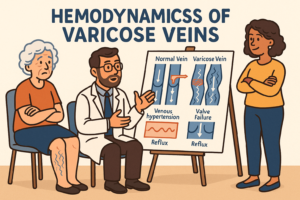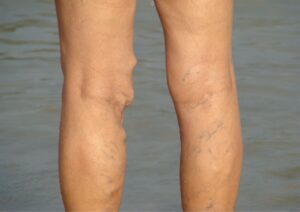Varicocele is a medical condition that affects the veins within the scrotum, the pouch of skin that holds the testicles. Often described as similar to varicose veins in the legs, a varicocele occurs when the veins inside the scrotum become enlarged and twisted, leading to discomfort, fertility issues, and sometimes long-term complications that can significantly affect fertility in men. Although varicocele is a common condition, affecting approximately 10-15% of men, varicocele often goes unnoticed unless it causes symptoms or complications. In this blog, we’ll explore what a varicocele is, its causes, symptoms, and the available treatment options.
What is a Varicocele?
A varicocele is the enlargement of the veins within the scrotum, specifically the pampiniform plexus, a network of veins that drains blood from the testicles. The spermatic cord, which holds the testicles, houses these veins and is crucial for proper blood drainage. Normally, these veins work to cool the blood before it reaches the testicles, which is important for maintaining optimal sperm production. However, when the valves within these veins malfunction, blood flow pools and causes the veins to enlarge, leading to the formation of a varicocele.
Causes of Varicocele
The exact cause of varicoceles is not entirely understood, but they are believed to result from valve dysfunction within the veins that are supposed to keep blood flowing in the right direction. When these valves fail, blood pools in the veins, causing them to dilate and become varicose. The dysfunction of the testicular vein valves is a primary factor in the development of varicoceles.
Varicocele typically develops during puberty and are more commonly found on the left side of the scrotum. This is due to anatomical differences in the way the veins drain blood from each side of the scrotum. However, varicoceles can also occur on the right side or on both sides.
Anatomy of a Varicocele
A varicocele is an abnormal enlargement of the veins within the scrotum, specifically those in the pampiniform plexus, which is a network of veins that drain blood from the testicles. Understanding the anatomy of a varicocele helps explain its development, symptoms, and potential impact on male fertility.
Key Anatomical Structures Involved:
1. Pampiniform Plexus:
– The pampiniform plexus is a network of veins located within the spermatic cord, which is the structure that runs from the abdomen to the testicles.
– This plexus plays a crucial role in cooling the blood before it reaches the testes, which is important for maintaining the optimal temperature for sperm production.
2. Spermatic Cord:
– The spermatic cord contains the vas deferens (the tube that carries sperm from the testicles), arteries, nerves, lymphatics, and the pampiniform plexus.
– The spermatic cord extends from the deep inguinal ring in the abdomen to each testicle.
3. Testicular Veins:
– Blood from the testicles drains through the pampiniform plexus into the testicular veins.
– The left testicular vein typically drains into the left renal vein, while the right testicular vein drains directly into the inferior vena cava. This anatomical difference is one reason why varicoceles are more commonly found on the left side.
4. Valves in the Veins:
– Normally, the veins within the pampiniform plexus contain one-way valves that prevent blood from flowing backward.
– When these valves fail or become incompetent, blood can pool in the veins, causing them to become dilated and form a varicocele.
Pathophysiology of Varicocele Formation:
1. Valve Failure:
– The primary cause of varicoceles is the failure of the one-way valves within the veins of the pampiniform plexus. This leads to the backflow and pooling of blood, resulting in vein dilation.
2. Increased Hydrostatic Pressure:
– Due to the anatomical position, particularly on the left side where the testicular vein drains into the left renal vein, there can be increased hydrostatic pressure. This pressure can contribute to the formation of a varicocele.
3. Venous Compression:
– Compression of the left renal vein between the aorta and the superior mesenteric artery (known as the “nutcracker effect”) can also increase pressure in the left testicular vein, promoting the development of a varicocele.
Types of Varicocele:
1. Primary Varicocele:
– This type occurs due to the aforementioned anatomical factors and is most commonly seen on the left side. It usually develops during puberty when the testes grow and blood flow increases.
2. Secondary Varicocele:
– Less common, secondary varicocele is caused by a compression or blockage of the veins by a mass or other pathology, such as a kidney tumor. It can occur on either side and may develop later in life.
The anatomy of a varicocele involves the complex interaction of veins within the scrotum and the factors that lead to their dilation. Understanding this anatomy is crucial for diagnosing the condition and understanding its potential impact on fertility. Regular medical check-ups and awareness of the symptoms can help in early detection and management of varicoceles.
Symptoms of Varicocele: Testicular Pain
In many cases, varicocele do not cause any noticeable symptoms and are often discovered during a routine physical examination or when evaluating fertility issues. However, when symptoms do occur, they may include:
Dull Pain or Testicular Pain: Men with varicocele may experience a dull, aching pain in the scrotum, particularly after standing for long periods or physical exertion. Testicular pain is a common symptom, although the exact source of the pain can sometimes be uncertain. The pain may be relieved when lying down.
Swelling or Enlargement: The affected side of the scrotum may appear swollen or enlarged. The veins may be visible or palpable, feeling like a “bag of worms” within the scrotum.
Fertility Problems: Varicocele can affect sperm production and quality, leading to issues with fertility. It is a common cause of low sperm count and decreased motility.
Testicular Atrophy: In some cases, the affected testicle may shrink in size (atrophy) due to the prolonged pooling of blood, which can damage the testicular tissue.
Diagnosis of Varicocele
A varicocele is usually diagnosed through a physical examination by a healthcare provider, who may feel the dilated veins within the scrotum. If the varicocele is large enough, it may be visible or easily felt when the patient is standing. In cases where the diagnosis is unclear, or to assess the severity of the varicocele, an ultrasound may be used to provide detailed images of the scrotal structures and confirm the presence of enlarged veins.
Varicocele and Fertility
Varicocele is closely linked to male infertility, being found in approximately 40% of men who are experiencing primary infertility (unable to father a child after one year of trying) and 80% of those with secondary infertility (unable to father a child after previously doing so).
The connection between varicoceles and fertility issues primarily revolves around the following factors:
Elevated Testicular Temperature: The veins in the scrotum play a role in regulating the temperature of the testicles. Varicocele can cause an increase in testicular temperature, which negatively impacts sperm production and quality.
Reduced Oxygen Supply: Poor circulation caused by the varicocele can reduce the oxygen supply to the testicles, affecting sperm production and function.
Oxidative Stress: Varicocele can lead to increased levels of oxidative stress in the testicles, which can damage sperm DNA and impair fertility.
Hormonal Imbalance: The presence of a varicocele can disrupt the normal hormone balance in the testes, particularly the production of testosterone, which is vital for sperm production.
Treatment Options for Varicocele: Varicocele Surgery
Not all varicocele require treatment, especially if they are asymptomatic and not affecting fertility. However, if the varicocele causes pain, testicular atrophy, or fertility problems, treatment may be recommended. Varicocele treatment options vary and can include surgical and non-surgical methods aimed at alleviating symptoms and improving fertility. The primary treatment options include:
1. Watchful Waiting
For men with mild symptoms or no symptoms at all, watchful waiting may be recommended. This involves regular monitoring of the varicocele to ensure it doesn’t worsen over time. Pain management with over-the-counter pain relievers and lifestyle modifications, such as wearing supportive underwear, may be suggested.
2. Varicocelectomy
Varicocelectomy is a surgical procedure to repair the varicocele by tying off the affected vein to ensure proper circulation through healthy veins. This procedure is typically done through a small incision in the groin or lower abdomen. It is considered effective in improving fertility and relieving symptoms in most men.
3. Percutaneous Embolization
Percutaneous embolization is a minimally invasive procedure in which a radiologist inserts a catheter into a vein in the groin or neck and guides it to the varicocele. A coil or a solution is then injected to block the enlarged veins, effectively diverting blood flow to healthy veins. This procedure is particularly beneficial for treating clinically significant varicoceles that impact fertility. This procedure is less invasive than surgery and has a shorter recovery time, but it is not as widely available as varicocelectomy.
4. Microsurgical Varicocelectomy
This is a specialized form of varicocelectomy performed using a surgical microscope. It allows the surgeon to precisely identify and repair the affected veins while minimizing the risk of damage to surrounding tissues, such as the arteries and lymphatic vessels. Special care is taken to avoid injury to the testicular artery, which is crucial for preventing complications such as testicular atrophy. Microsurgical varicocelectomy has a high success rate and a lower risk of complications compared to other surgical methods.
Complications of Untreated Varicocele: Male Infertility
If left untreated, a varicocele can lead to several complications, particularly if it affects sperm production and quality. These complications may include:
Infertility: Varicoceles are a common cause of male infertility. They can lead to a decrease in sperm count, motility, and morphology, making it difficult to conceive. Varicoceles can lead to impaired fertility, which is a significant cause of abnormal semen analysis and low sperm count.
Testicular Atrophy: The affected testicle may shrink in size over time, which can result in reduced testosterone production and potential fertility issues.
Chronic Pain: Some men may experience ongoing pain or discomfort, which can interfere with daily activities and quality of life.
To diagnose a varicocele, a physical examination is usually performed to confirm the presence of enlarged veins. Even subclinical varicoceles, which are not easily detectable, can impact reproductive success and should be evaluated.
Conclusion: Understanding and Managing Varicocele
Varicocele is a common condition that can impact male fertility and quality of life, but it is also manageable with appropriate treatment. Whether you’re experiencing symptoms or have been diagnosed during a routine examination, it’s important to discuss your options with a healthcare provider. With proper management, most men can find relief from symptoms and improve their chances of fertility if desired.
In summary, while a varicocele might sound concerning, understanding its causes, symptoms, and treatment options can help you make informed decisions about your health. Whether opting for watchful waiting, surgical intervention, or another treatment method, addressing a varicocele can lead to improved outcomes and better overall well-being.









